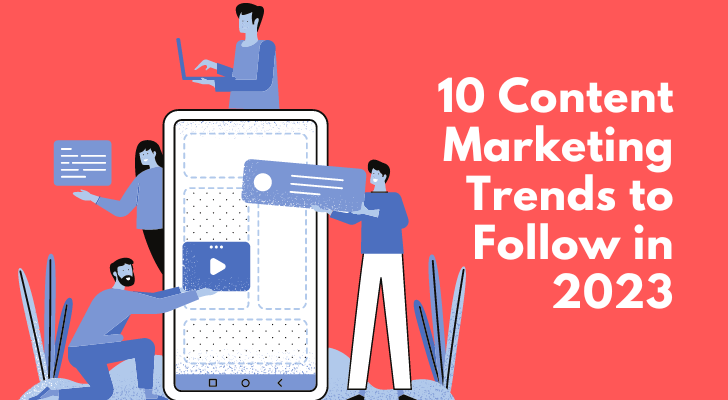Content marketing is an ever-changing aspect of marketing. As new technology comes into the fray, marketers must figure out ways to implement it in order to meet users’ needs and generate more revenue.
For instance, an edTech company offering various educational solutions for universities and students can hire a expert writer to create relatable content for Gen Z and Millenials. This approach to content marketing will become common in 2023 as a response to the demands of the target demo.
In this article, we’ll look at the content marketing trends to follow in 2023. Let’s go through them.

1. Interactive content
Static posts are not going anywhere, but they are gradually making way for interactive content—content that will keep users engaged with your content. Some standard forms of interactive content include:
- Infographics
- Games and calculators
- Quizzes and polls
You can hire seasoned writers to create interactive content that will stop users in their tracks and get them to spend more time on your website or platform.
Furthermore, augmented reality (AR) can also provide a better customer experience. Companies like IKEA use AR apps to improve the shopping experience for buyers.
2. Video and podcasts
In the coming year, businesses will pay more attention to video content and podcasts. Customers gravitate towards this type of content because it is more engaging and easily consumable.
Going forward, brands will repurpose their written content into podcasts and videos. Google, Figma, and Meta offer several podcasts and video content to their customers across multiple channels.
3. Long-term influencer relationships
In the past, brands held short-term contracts with influencers. One influencer could work with a brand on a couple of projects before moving to another brand. But in 2023 and beyond, brands will go into longer partnerships with influencers. This strategy will help companies build familiarity across different fanbases, as having a familiar face drives more engagement. A great example is the “Verizon guy” Paul Marcarelli, who has become synonymous with the Verizon brand.
4. User-generated content

As the name suggests, user-generated content comes from dedicated consumers who identify with your brand on a personal level. User-generated content could appear in the form of challenges, trends, unboxing videos, product reviews, and branded hashtags.
Going forward, companies will trust their customers to generate content, thus establishing a closer brand association. With channels like Reels and TikTok increasing in popularity, more brands will have to come up with more creative content, as Nike did with the NikeID campaign.
5. Agile marketing
Agile marketing is an offshoot of the Agile methodology. Instead of treating content marketing as a separate entity from the rest of the business, companies will adopt the methodology to their marketing strategies across all channels.
Agile marketing allows brands to iterate on changes faster than their competitors. It also enables companies to deliver value and focus on data-driven testing. And most importantly, it keeps the company flexible to the ever-changing market demands.
6. Emphasis on privacy
Data privacy and security have become hot-button topics in the past few years, yet most companies still need to implement better privacy rules for protecting user data. In the coming year, companies will put more effort into safeguarding user data. This shift in attention will feature in cookie policies and data storage regulations.
More so, promoting data privacy and transparent data usage policies attracts more users to your platform, increasing engagement and conversions. And most importantly, it will reduce the frequency of cyber-attacks and identity theft.
7. Voice search SEO
A significant part of technical SEO revolved around typed searches. Keywords and search queries reflect the way people search for information. But going forward, companies will have to pay more attention to voice search when optimizing their content for search.
Voice search SEO includes adding questions that people could ask Siri, Cortana, or Alexa. For instance, “how high is the Eiffel Tower?” or “Is there a Subway near me?”
By optimizing voice search intent, companies can increase traffic to content, thereby satisfying their customers’ needs.
8. Using chatbots

With the rise of artificial intelligence, machine learning, and natural language processing, brands now have the tools to automate responses using chatbots. Facebook, Instagram, and LinkedIn all use automated responses and chatbots to provide instant services to consumers.
But in 2023, more startups and companies will adopt these chatbots to address frequently asked customer questions.
9. Focus on social responsibility
Modern consumers no longer want to shop without any care in the world. They want to buy things from brands that share the same values as them.
With political movements like Just Stop Oil gaining steam, companies will need to clarify their stance on social issues. Brands with a clear stance on recycling, social change, diversity, and inclusivity have increased engagement.
10. Advanced analytics
Companies will have to invest more in data analytics to get a bead on the market and their consumers. This involves gathering consumer data and analyzing it using tools like Google Analytics. By analyzing and synthesizing these results, brands can get real-time insights into what their customers need to improve the quality of the solutions they provide.
Conclusion
Companies of all sizes will have to adjust their content marketing strategies to meet the demands of the changing landscape. Interactive content will become the norm, as well as video content. Influencers will go into long-term contracts with brands. Companies will have to dedicate more attention to privacy, analytics, and social responsibility in order to appeal to younger consumers.
What Do You Advocate?
